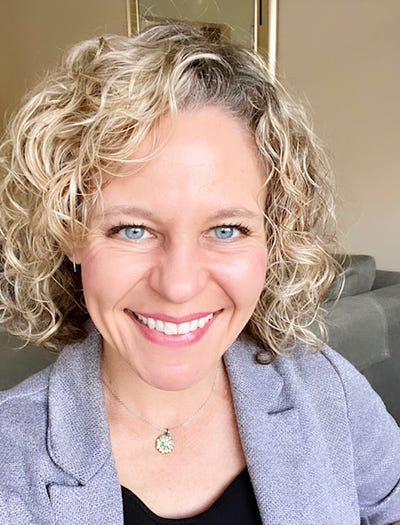Q&A: Helping Grocery Retailers Source More SustainablyQ&A: Helping Grocery Retailers Source More Sustainably
'I think one thing that is probably a bit of a surprise to companies ... is that they can’t stop at just the final packaging,' says Boma Brown-West of the Environmental Defense Fund. "I think one thing that is probably a bit of a surprise to companies that want to get started, that want to take action, is that they can’t stop at just the final packaging," says Boma Brown-West, a Whirlpool veteran, mechanical engineer and current director of consumer health at the Environmental Defense Fund.

Boma Brown-West is director of consumer health for the Environmental Defense Fund in Washington, D.C. In that role, she works closely with CPG manufacturers as well as retailers such as Walmart on developing sustainability strategies that focus not only on finished products and packaging but also ensuring that safer chemicals are used throughout the sourcing and manufacturing process. Prior to joining EDF, Brown-West, who has an Master of Science in technology and policy from MIT and a Bachelor of Science in mechanical engineering from Yale, spent a decade at Whirlpool Corp. in product engineering and sustainability.
EDF, Brown-West noted, has been working with Walmart for more than a decade on cleaning up household products and packaging, and a list of leading chemicals that consumer packaging should be free from is included as one of Walmart's supplier criteria for its recently launched Circular Connector tool. Walmart's Circular Connector, announced April 11, seeks to connect suppliers seeking more-sustainable packaging options—Walmart has more than 100,000 suppliers worldwide—with manufacturers that can provide them. EDF called the Circular Connector "a major milestone in helping Walmart and the brands it carries (e.g., Loreal and Lysol) to put safe products and packaging on store shelves."
In an interview with WGB, Brown-West discussed the need for a more-holistic approach to sustainability across the supply chain—and where CPG brands and retailers can start.
Christine LaFave Grace: EDF has been working with Walmart since before many retailers adopted sustainability statements and started tracking their ESG progress—can you share more about that relationship?
Boma Brown-West: Yes—in addition to our work with them on climate, we’ve also actively worked with them for several years on sustainable chemistry, which is really about trying to reduce the toxic chemicals that are in everyday products. With guidance from us, in 2013, Walmart developed its groundbreaking sustainable chemistry policy that was focused on formulated products: cleaning products, beauty and personal care products. And then just as they did with their climate goal, where they kept on evolving and setting more ambitious goals, they also set a more ambitious sustainable chemistry goal in 2017 that we’ve been working with them on achieving as well.
With respect to Walmart’s work on more-sustainable retail, we’ve provided advice on some of the pathways they could take toward achieving their sustainable-packaging goals. Part of that has been around making sure that the definition of sustainable packaging also includes sustainable chemistry. For packaging to be sustainable, yes, we need to look at whether or not it’s single-use, how much recycled content there is, what are the starter materials, but we also need to look at the chemical contents of packaging, especially when we’re talking about packaging for products that we either eat or put on our bodies. That’s how we’ve tried to help build that bridge between your typical sustainability topics and chemicals, chemical safety.
See also: Sam's Club Aims to Make Member's Mark More Sustainable
[For example], PFOS, the forever chemicals, have certainly been in the news a lot, but people have really associated them with water repellency on clothing, with firefighting foam, with stain guards for furniture. But PFOS are also really pretty prevalent in packaging, especially paper packaging. And now due to some sleuthing from our team and others in the space, we’ve now seen that PFOS show up in many types of plastic packaging, too.
It’s not just something we have to worry about when it comes to paper packaging; now we also have to dig into the plastic supply chain and really have brands and retailers gain better visibility into all of the potential types of chemicals that may be used in the plastic production process. Because getting that transparency, getting that information is the first step toward taking action.
What surprises CPG makers and suppliers as they're working to incorporate product packaging into their sustainability strategy?
I think one thing that is probably a bit of a surprise to companies that want to get started, that want to take action, is that they can’t stop at just the final packaging. When you really think about the product supply chain and all of those steps from ingredient sourcing and processing and final assembly—packaging is part of all of that. And in particular, when you’re talking about the food supply chain, that means there are many opportunities for undesirable chemicals to contaminate food. Companies need a holistic strategy when it comes to safer, more sustainable packaging.
What questions do you get most from suppliers and retailers, and how have those changed in the past several years?
I think in the early days, thinking of chemical safety as part of sustainability wasn’t completely part of how people thought about sustainability. So I think early questions were around, “How is this tied to sustainability?”
But I think increasingly, as more and more major companies have set out policies or commitments to eliminate certain chemicals, they’ve really sort of grown in their understanding of the importance of taking on chemical safety from a reputation standpoint, with consumers, with their investors, from a regulatory standpoint—what can they do to get ahead of regulations?
Now you see more companies in the space of, “Yes, I want to tackle this problem.” But now the bigger questions are around, “What are the alternatives that I can move into?” and, “How can I determine that these alternative ingredients are going to be better?” I think another question, too, is, “How do I get that full understanding of my supply chain? Where do I start?” Because companies are trying to balance how to do this in a comprehensive way but also in a way that is not incredibly taxing on their own staff and on the staff of their suppliers.
To that point, then—for suppliers and retailers unsure exactly where and how to start, or restart, on this path, what resources does EDF point them to?
We try to provide guidance not only in our blogs but also in evergreen resources on our site for companies that we’re not able to engage directly. We try to provide advice in terms of, what are the chemicals that they should be focusing initial attention on? Unfortunately, just with plastic, for example, there are more than 10,000 different chemicals used in plastic manufacturing, and 2,000 of those have been seen to be harmful to human health. That’s a lot to cover at once, so in some of our guidance we try to help companies figure out how to get a better baseline understanding of what’s in their products, and what can they get started on first?
There are also allies of ours who are trying to create databases of safer alternatives to commonly used chemical ingredients in packaging to try to take some of that guesswork out for companies that want to make that change but wonder, “Where do I go to find some of those safer alternatives?”
On the supply-chain front, are you seeing demand outstrip supply for some of these safer and more-sustainable alternatives?
I think there’s definitely that supply-and-demand tension going on there, because there is this increased demand for more innovative options. Especially for smaller-scale innovators, they’re working as much as they can to be able to meet that large demand that conventional packaging solutions can do today, [but] you always see that when there are new innovations that come into the marketplace. They definitely add an additional level of pain in the system. That’s an unfortunate extra piece of the puzzle here for companies that are trying to do the right thing and still get product out the door.
What are areas where you see the greatest room for improvement from suppliers and retailers? Or conversely, as we see sustainability increasingly at the fore in conversations from some of these big brands, what are you looking for, and what are you looking forward to seeing?
I’m excited to see brands and retailers show up. OK, we’ve seen these commitments, seen companies joining these collective efforts—what are the specific plans to achieve those goals? And not just the plans, but how’s the progress going? What are the key things that are happening?
I think from a materials standpoint, I think there is a ripe opportunity for balancing between improving our recycling infrastructure, because it desperately needs it, but also making sure that what we’re putting in place is not going to be harmful to us on the flip side, so that we’re increasing recycling rates, but at the same time, as we’re designing new packaging materials, we’re putting at the core that we want these to be truly sustainable with safer components in them and that we’re doing the best that we can across the packaging spectrum—not just focusing on that end stage.
About the Author
You May Also Like






